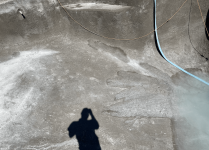Hi All! Under construction, first time poster here. Seems like a really great community.
30k gallon pool. IG Gunite.
After excavation, we had a moderate amount of groundwater collecting in deep-end. Mostly through a vertical wall at the shallow end, then flowing to deep end, oddly enough.
We finished gunite ~36 hours ago. The PB left three larger weep holes near/in the deep end, and those are getting a little activity. Expected.
However - before watering the gunite this afternoon, I noticed that there were several damp locations already on the gunite floor - and read about how some level of weeping through the gunite is ok/normal. However, we have one weep spot where the water is visibly trickling through. Downhill of this particular weep spot, there's a pretty significant amount of white residue and what looks like dirt/sand.
Question 1: Should I be concerned about shell structural integrity with weeping that is essentially a small trickle? I poked around on the gunite a bit, and it seems....softer/sandier? in this one spot.
Question 2: How are the intentional weep holes closed? Always plaster? (we will be doing pebblesheen).
Question 3: Is there a threshold of weeping at which plaster doesn't create an impermeable barrier? I'm trying to avoid both structural and leak/stain issues down the road.
I attached a picture of the weep spots. The spot closest to my shadow is the "trickle," and the deep end of the pool is to the right in the picture.
Thanks all!

30k gallon pool. IG Gunite.
After excavation, we had a moderate amount of groundwater collecting in deep-end. Mostly through a vertical wall at the shallow end, then flowing to deep end, oddly enough.
We finished gunite ~36 hours ago. The PB left three larger weep holes near/in the deep end, and those are getting a little activity. Expected.
However - before watering the gunite this afternoon, I noticed that there were several damp locations already on the gunite floor - and read about how some level of weeping through the gunite is ok/normal. However, we have one weep spot where the water is visibly trickling through. Downhill of this particular weep spot, there's a pretty significant amount of white residue and what looks like dirt/sand.
Question 1: Should I be concerned about shell structural integrity with weeping that is essentially a small trickle? I poked around on the gunite a bit, and it seems....softer/sandier? in this one spot.
Question 2: How are the intentional weep holes closed? Always plaster? (we will be doing pebblesheen).
Question 3: Is there a threshold of weeping at which plaster doesn't create an impermeable barrier? I'm trying to avoid both structural and leak/stain issues down the road.
I attached a picture of the weep spots. The spot closest to my shadow is the "trickle," and the deep end of the pool is to the right in the picture.
Thanks all!


